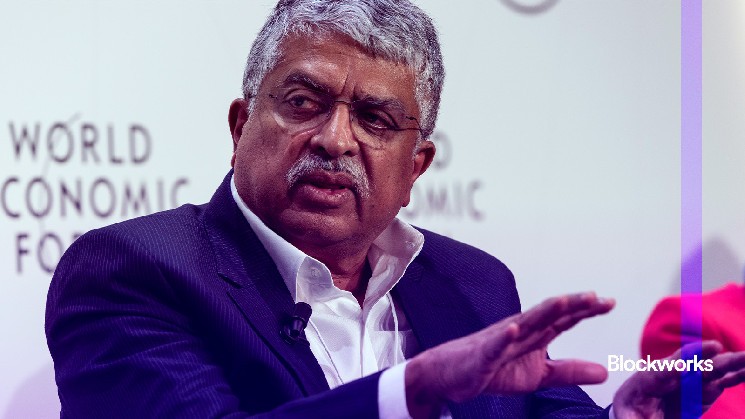Indian tech magnate teases Solana-built ‘finternet’ for an economy onchain

Today, enjoy the Lightspeed newsletter on Blockworks.co. Tomorrow, get the news delivered directly to your inbox. Subscribe to the Lightspeed newsletter.
Whenever a big name in the financial world saunters into blockchain, a healthy dose of skepticism is warranted. Institutional blockchain initiatives can oftentimes be more about firms saying they’re doing something than about actually doing something.
One initiative that I’ve been trying to tease apart the seriousness of is the “finternet,” a forward-looking financial system being championed by some of the contributors to India’s UPI digital money system.
The Bank for International Settlements penned a paper with the financial magnate Nandan Nilekani, who co-founded India’s sixth-largest company by market cap, about the finternet in April of this year. Since then, the team has been on the talk circuit.
In late August, Nilekani and Siddharth Shetty, who was formerly an advisor to the Indian Ministry of Finance, demoed the finternet in a talk at Global Fintech Fest. In the demo, the Indian businessman shows off the finternet sending 2,000 rupees and settling the transaction on Solana.
Then last month at Solana Breakpoint, Shetty gave a talk about the finternet which admittedly was a bit of crypto word salad, but he did get into the idea of assets being tokenized on multiple interoperable financial ledgers — that is, building the economy on blockchain rails instead of traditional financial rails.
The finternet is in its very early stages, one person who helped work on the demo told me. And the finternet team, obviously, is not the first to have the idea of moving economic activity onchain. But what interests me is the names involved — and what they imply about the potential stakes for a project that’s integrated itself with Solana.
Nilekani’s Infosys IT company is worth $94 billion, and he and Shetty were involved in building India’s Unified Payments Interface, or UPI, the Solana Foundation and Shetty have said. The Indian government rolled out UPI in 2016 as part of a broader digitization movement in the country. It’s a quite ambitious, albeit offchain, digital payments program that processed over 100 billion transactions between Indians in 2023.
The finternet is wholly distinct from UPI, according to multiple people I spoke to. It’s more about unifying the financial system across asset types and geographies.
The Solana Foundation and Superteam India — a Solana community organization — are both listed as contributors to the finternet sandbox.
At the end of the day, maybe the finternet project won’t turn out to be much. But when we talk about large institutional projects involving Solana — the Visas, PayPals, and Stripes of the world — perhaps it’s worth throwing the finternet in there as well.





 Bitcoin
Bitcoin  Ethereum
Ethereum  Tether
Tether  USDC
USDC  Dogecoin
Dogecoin  Cardano
Cardano  TRON
TRON  Chainlink
Chainlink  Bitcoin Cash
Bitcoin Cash  LEO Token
LEO Token  Litecoin
Litecoin  Dai
Dai  Stellar
Stellar  Ethereum Classic
Ethereum Classic  Monero
Monero  Cronos
Cronos  Stacks
Stacks  OKB
OKB  Hedera
Hedera  Cosmos Hub
Cosmos Hub  Maker
Maker  KuCoin
KuCoin  Theta Network
Theta Network  Gate
Gate  Algorand
Algorand  Polygon
Polygon  NEO
NEO  EOS
EOS  Tezos
Tezos  Tether Gold
Tether Gold  Zcash
Zcash  Synthetix Network
Synthetix Network  TrueUSD
TrueUSD  IOTA
IOTA  Bitcoin Gold
Bitcoin Gold  Holo
Holo  Dash
Dash  0x Protocol
0x Protocol  Zilliqa
Zilliqa  Siacoin
Siacoin  Enjin Coin
Enjin Coin  Ravencoin
Ravencoin  Qtum
Qtum  Basic Attention
Basic Attention  Decred
Decred  Ontology
Ontology  NEM
NEM  Lisk
Lisk  Nano
Nano  Numeraire
Numeraire  Waves
Waves  Pax Dollar
Pax Dollar  DigiByte
DigiByte  Status
Status  Hive
Hive  Huobi
Huobi  Steem
Steem  BUSD
BUSD  Ren
Ren  OMG Network
OMG Network  Bitcoin Diamond
Bitcoin Diamond  Bytom
Bytom  Kyber Network Crystal Legacy
Kyber Network Crystal Legacy  HUSD
HUSD